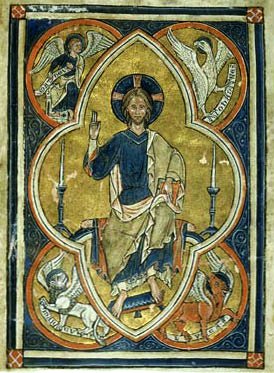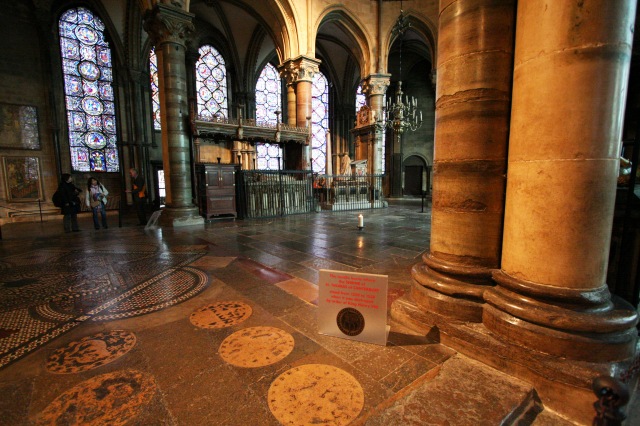The Traditional Symbolism of Four
 This can be something of interest to us and the basis of a powerful lesson for our children. Recently I wrote an article about the idea that the number five was symbolic of Our Lady, here. In it I raised a doubt in mind about the suggestion that it was part of the tradition. This doubt existed because of the lack of scriptural references or works of the Church Fathers citing it.
This can be something of interest to us and the basis of a powerful lesson for our children. Recently I wrote an article about the idea that the number five was symbolic of Our Lady, here. In it I raised a doubt in mind about the suggestion that it was part of the tradition. This doubt existed because of the lack of scriptural references or works of the Church Fathers citing it.
This can be contrasted with consideration of symbolism of the number four. Unlike the number five we have references from many different sources that point to a longstanding and firmly established tradition of Christian symbolism of the number four. We can also see how this symbolism has been reflected in the culture, through art for example. There are biblical references and the writings of the Church Fathers, some of which are included in the liturgy of the Church.
What brought this to mind was a passage in the Office of Readings from the book of the Apocalypse. The passage is from Rev. 7 and begins as follows: 'I, John, saw four angels standing at the four corners of the earth, holding back the four winds of the earth, so that no wind should blow the earth, the sea or any tree.'
This statement links the created world, the earth, to the number four. We can also see how these expressions (the four winds and the four corners of the earth) derive these common usages. We can see also, why it would be natural to divide the points of the compass up into four quadrants. There are other references to the four winds in the bible, most importantly, Christ himself spoke of the four winds in Matthew 24 and Mark 13 in which we can see the parallels with the passage in the Apocalypse immediately, for example:
"And then shall appear the sign of the Son of man in heaven: and then shall all the tribes of the earth mourn, and they shall see the Son of man coming in the clouds of heaven with power and great glory. And he shall send his angels with a great sound of a trumpet, and they shall gather together his elect from the four winds, from one end of heaven to the other." (Mt 24: 30,31) This seems to extend the number four to a way of meaning 'everywhere' because he is applying it here to heaven as well.
Famously, St Irenaeus wrote in the 2nd century AD in his treatise, Against Heresies:
 "There are four gospels and only four, neither more nor less: four like the points of the compass, four like the chief directions of the wind. The Church, spread all over the world, has in the gospels four pillars and four winds blowing wherever people live. These four gospels are in actual fact one single Gospel, a fourfold Gospel inspired by the one Spirit, a Gospel which has four aspects representing the work of the Son of God. These aspects are like the four cherubs described by Ezekiel. In the prophet's words: `The first had the like ness of a lion,' symbolizing the masterly and kingly role of Christ in priesthood; `the second had the appearance of an ox,' the beast of sacrifice, recalling the perfect sacrifice of Christ; `the third had the face of a man,' undoubtedly referring to the coming of the Lord in human nature; `and the fourth had the aspect of a flying eagle,' with a clear allusion to the grace of the Spirit hovering over the Church. [cf. Ezek. 1:10; Rev. 4:7] The four Gospels correspond to these symbols. Christ is at the center of them. John actually speaks of his kingly and glorious Sonship to the Father in his opening words: `In the beginning was the Word.' [John 1:1] Luke begins with Zaccharias offering sacrifice. Matthew chooses first of all the Lord's human genealogy. And Mark leads off by calling on the prophetic Spirit which invests humanity from on high."
"There are four gospels and only four, neither more nor less: four like the points of the compass, four like the chief directions of the wind. The Church, spread all over the world, has in the gospels four pillars and four winds blowing wherever people live. These four gospels are in actual fact one single Gospel, a fourfold Gospel inspired by the one Spirit, a Gospel which has four aspects representing the work of the Son of God. These aspects are like the four cherubs described by Ezekiel. In the prophet's words: `The first had the like ness of a lion,' symbolizing the masterly and kingly role of Christ in priesthood; `the second had the appearance of an ox,' the beast of sacrifice, recalling the perfect sacrifice of Christ; `the third had the face of a man,' undoubtedly referring to the coming of the Lord in human nature; `and the fourth had the aspect of a flying eagle,' with a clear allusion to the grace of the Spirit hovering over the Church. [cf. Ezek. 1:10; Rev. 4:7] The four Gospels correspond to these symbols. Christ is at the center of them. John actually speaks of his kingly and glorious Sonship to the Father in his opening words: `In the beginning was the Word.' [John 1:1] Luke begins with Zaccharias offering sacrifice. Matthew chooses first of all the Lord's human genealogy. And Mark leads off by calling on the prophetic Spirit which invests humanity from on high."
Then in art we can see many examples of painting of Christ in Majesty from Eastern and Western traditions portraying this. Furthermore, as I have mentioned before, here, the quincunx, used in many decorative patterns in Churches, particularly on Church floors always strikes me as a geometric portrayal of this. The quincunx is a pattern that comes originally from the Romans and was brought into the Christian culture.
Last week I wrote about the importance of praying the Liturgy of the Hours in forming the minds of children. I cannot overemphasise how much the liturgy teaches directly as well as nourishes spiritually. On any given day the scriptural passages are selected that have common themes and so parallels between, for example, old and new testaments that would be lost if I was only attending Mass. These are often emphasised further by the choice of passage from the Fathers in the Office of Readings. In regard to this particular instance, imagine how much of an impression it would make on any impressionable mind to hear this passage read and then as part of their art lesson for that day to hear the other references to it, then to asked both to copy an illumination of the scene from a traditional psalter and to construct with just straight edge and a pair of compasses the quincunx. This I suggest would connect forever in their minds the liturgy, the cosmos, the four Evangelists and their gospels, and the culture.
Images from top: Psalter of St Louis and Blanche of Castille, 13th century; Peterborough Abbey Psalter, 13th century; the De Lisle Psalter, 14th century; the final three photos are of Trinity Chapel in Canterbury Cathedral. The floor design date is uncertain, but possibly 12th or 13th century.



